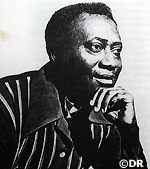Independence and music: continental repercussions from the Congos
Rumba without borders
Paris
02/07/2010 -
 |
 |
In the period before and just after gaining independence from their respective Belgian and French colonial powers, Brazza discretely served as a safe base for musicians whenever things grew tense on the other side. Most musicians worked in Léopoldville, as Kinshasa was then known, which was an Eldorado for instrumentalists and singers at the time: in a little less than a decade, a whole economic environment grew up around music. The industry flourished, with increasingly numerous venues playing to a growing clientele in a town absorbing a constant stream of new arrivals. From an estimated 100,000 inhabitants in 1945, the population grew to 400,000 in 1960 and hit 900,000 in 1967, entertained by over thirty major bands at the time.
The record industry started up there in 1948, under the impetus of Nicolas Jeronimidis who was quickly followed by Greek compatriots also living in the Belgian colony. These efficient, intuitive salesmen saw the potential for an obvious growth market. The conditions were ideal to match local supply with demand.
One factor was that the GV series 78 rpm vinyls, deliberately exported to Africa at low cost by His Master’s Voice, had started to find an audience, especially those by Cuban artists. Another factor was that the Congolia radio station, which had started up a few years earlier, had the innovating idea (barely imaginable at the time) of recording African music for an African audience.
Group affair

The “coastmen” also brought guitars in their luggage and a way of playing that inspired the local musicians they met. Henri Bowane was the first Congolese guitarist to shine at playing rumba. His partnership with Wendo Kolosoy, for the label Ngoma created by Jeronimidis, was sealed with tracks like Marie-Louise, a huge hit first released in 1948. Sales were so high that the producer bought them a house and a car! Their 1953 nationwide tour with Manuel D’Oliveira went like a bomb: at each venue, the B.O.W. Trio was welcomed by a huge crowd who had heard the news on the traditional tam-tam.
That same year, Bowane, who was also artistic director of Basile Papadimitriou’s Loningisa label, auditioned a 15-year-old boy nicknamed Franco whose guitar playing was impressive. The rise of the young prodigy and that of his group OK Jazz quickly made him the most serious contender to Joseph Kabasele, star of the Opika label along with his African Jazz band.
Indépendance cha cha
During one of these European stays, Kabasele noticed Manu Dibango in a club and managed to convince him to follow him home. The Cameroonian saxophonist made his first real breakthrough into African music there, recording the track Ekedy. In the space of a few years, the reputation of Congolese rumba had spread over the whole continent. The Beguen Band, on the Ngoma label, performed in Ghana and Côte d’Ivoire in 1960, and in Togo, the Orchestre des Bantous de la Capitale was invited to take part in the independence celebrations. Formed a few months earlier in Brazzaville, it included musicians who had played with Franco and other artists, like Jean-Serge Essous.
Music makes profits
 |
 |
The taste for money sowed the seeds of discord, and the players started to question those in charge. Kabasele paid the price in 1963, when he came back with his band from a long tour of Mali, Upper Volta, Senegal and Liberia. Without letting him know, not one of his musicians turned up at his wedding – they had fired their boss and left for the recording studio to honour a commitment in his name!
African Jazz renamed itself African Fiesta, but the new band split in two, a victim of friction between guitarist Docteur Nico and singer Tabu Ley Rochereau, who had remained in the shadow of leader Kabasele for some time. His pupil certainly didn’t lack talent, and in 1969 he was the first Congolese to get onto the stage at Olympia in Paris. A symbolic victory in the history of rumba.
Bertrand Lavaine
Translation : Anne-Marie Harper
18/05/2009 -
07/01/2008 -
02/07/2007 -
21/10/2002 -











